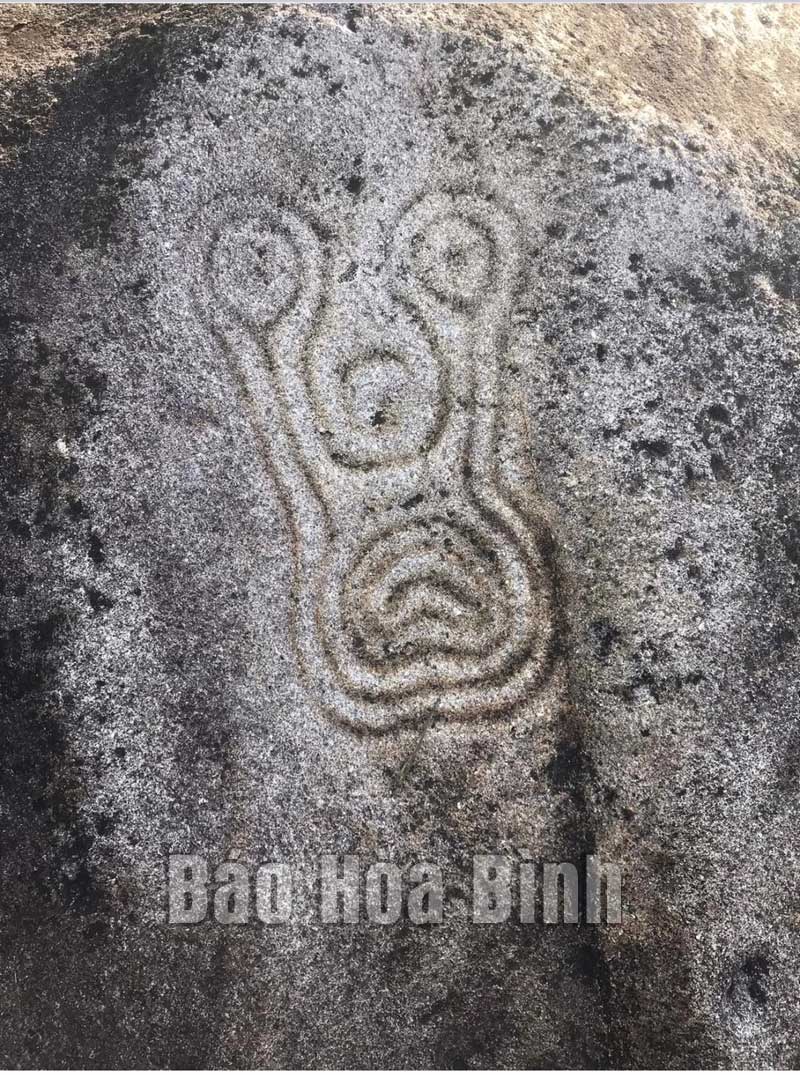
(HBO) – The Hoa Binh provincial Department of Culture, Sports and Tourism has coordinated with the Centre for Southeast Asian Prehistoric Studies to conduct a study of stone carvings on Co Spring in My Thanh commune, Lac Son district. The carvings are linked with the old belief of residents in local mountainous areas in the past, home to many relics of the Hoa Binh Civilisation over 20,000 years ago.
A big stone carving with concentric circles on Co
Spring in My Thanh commune, Lac Son district.
So far, only two rocks with carvings have been
discovered, about 25m apart. Both are granite, relatively big - about 5 cu.m.,
and half-submerged on the eastern bank of Co Spring.
The first rock (Block A) features a relatively
large carving that measures 25 x 35cm. The carving was formed from concave
lines about 1.5cm in width and 0.7cm in depth, clearly showing a paunchy person
with arms up. On the top of the two arms are two concentric circles with dots
at the centre and the outer circles about 6 - 7cm in diameter. Concentric
circles were a popular motif of patterns on bronze objects of the Dong Son
Civilisation.
Located about 20 - 25m from Block A, to the
spring’s upstream part, is a little bigger rock (Block B) that features four
clusters of relatively similar carvings on its flat top. The patterns cover an
area measuring 40 x 60cm. Each cluster includes two concentric circles about 7
- 8cm in diameter atop, and an almost square shape with two concave holes like
two nostrils below.
About 50m from those two objects is another rock
with part of it rising above the ground. The exposed part is 125cm long and
60cm wide and, especially, features nine concave holes which are about 6 - 9cm
in diameter, inspiring the imagination of a fish.
Dr Nguyen Viet, Director of the Centre for
Southeast Asian Prehistoric Studies, said only two rocks with five carving
clusters have been found at the site. Three of the clusters have clear lines
while two others do not. However, their styles are relatively consistent and
have the common theme of animal-like human faces. The concentric circles,
bearing the decoration style of the Dong Son Civilisation, demonstrate eyes,
noses, and mouths in a relatively similar way. The carving on Block A is
particularly important since it is bigger and faces outwards.
Notably, the stone carvings show the
skillfulness of shamans in the past, he noted, adding it is hopeful that more
relics of ancient rituals will be discovered in nearby areas./.
With an increasingly vibrant and widespread emulation movement aimed at building cultured residential areas and cultured families, Yen Thuy District has been making steady progress toward improving both the material and spiritual well-being of its people, while fostering a civilized, prosperous, beautiful, and progressive community.
Once lacking recreational spaces and community facilities, Residential Group 2 in Quynh Lam Ward (Hoa Binh City) has recently received attention for the construction of a new, spacious, and fully equipped cultural house. The project followed the model of state support combined with public contributions in both labor and funding.
The "All people unite to build cultural life" movement, which has been effectively integrated with Kim Boi district’s socio-economic development goals, is fostering a lively spirit of emulation across local residential areas, hamlets, villages, public agencies, and enterprises. In addition, through the initiative, traditional cultural values are being preserved and promoted, while community solidarity and mutual support in poverty reduction and economic development are being strengthened.
A working delegation of the Hoa Binh provincial People’s Committee led by its Permanent Vice Chairman Nguyen Van Toan on June 11 inspected the progress of a project to build the Mo Muong Cultural Heritage Conservation Space linked to tourism services in Hop Phong commune, Cao Phong district.
Born and growing in the heroic land of Muong Dong, Dinh Thi Kieu Dung, a resident in Bo town of Kim Boi district, in her childhood was nurtured by the sweet lullabies of her grandmother and mother. These melodies deeply imprinted on her soul, becoming an inseparable part of her love for her ethnic group's culture. For over 20 years, this love for her hometown has driven Dung to research, collect, and pass down the cultural values of the Muong people to future generations.
In the final days of May, the Ethnic Art Troupe of Hoa Binh Province organized performances to serve the people in remote, mountainous, and particularly disadvantaged areas within the province. These were not just ordinary artistic shows, but they were the meaningful journeys aimed at spreading cultural values, enhancing the spiritual life of the people and contributing to the preservation of ethnic minority cultural identities.



